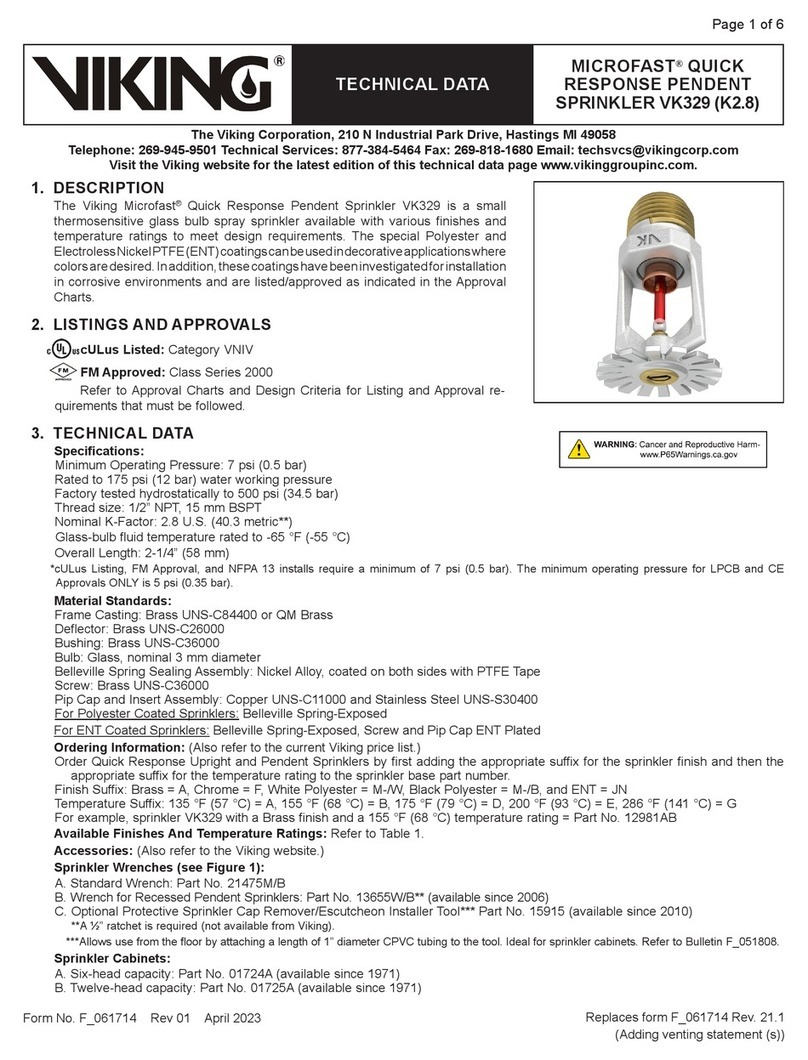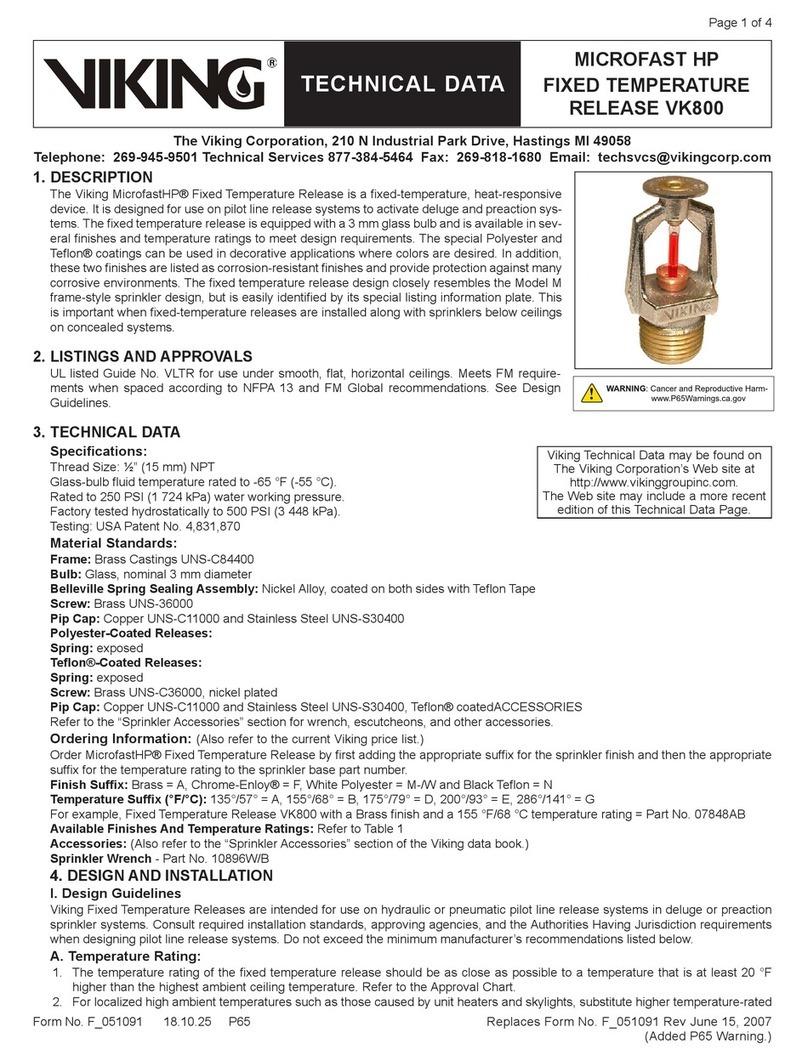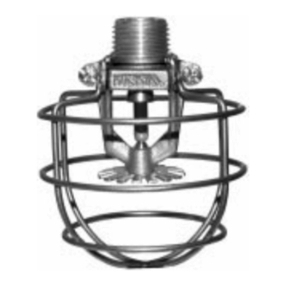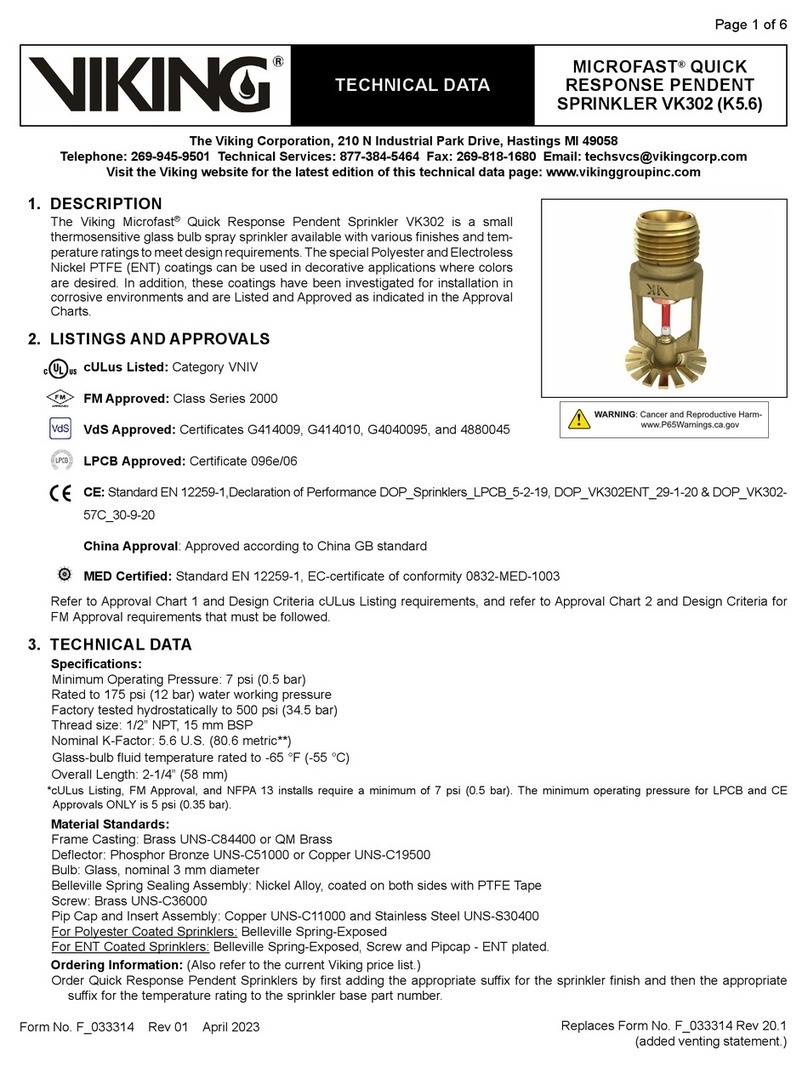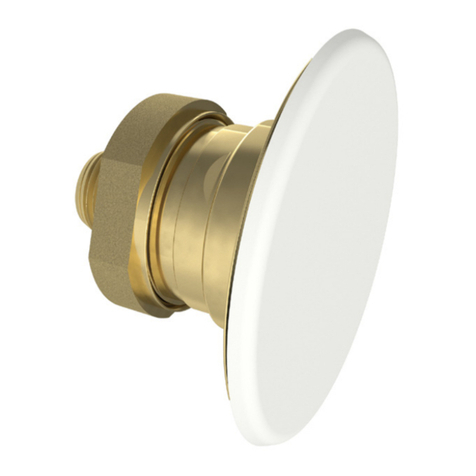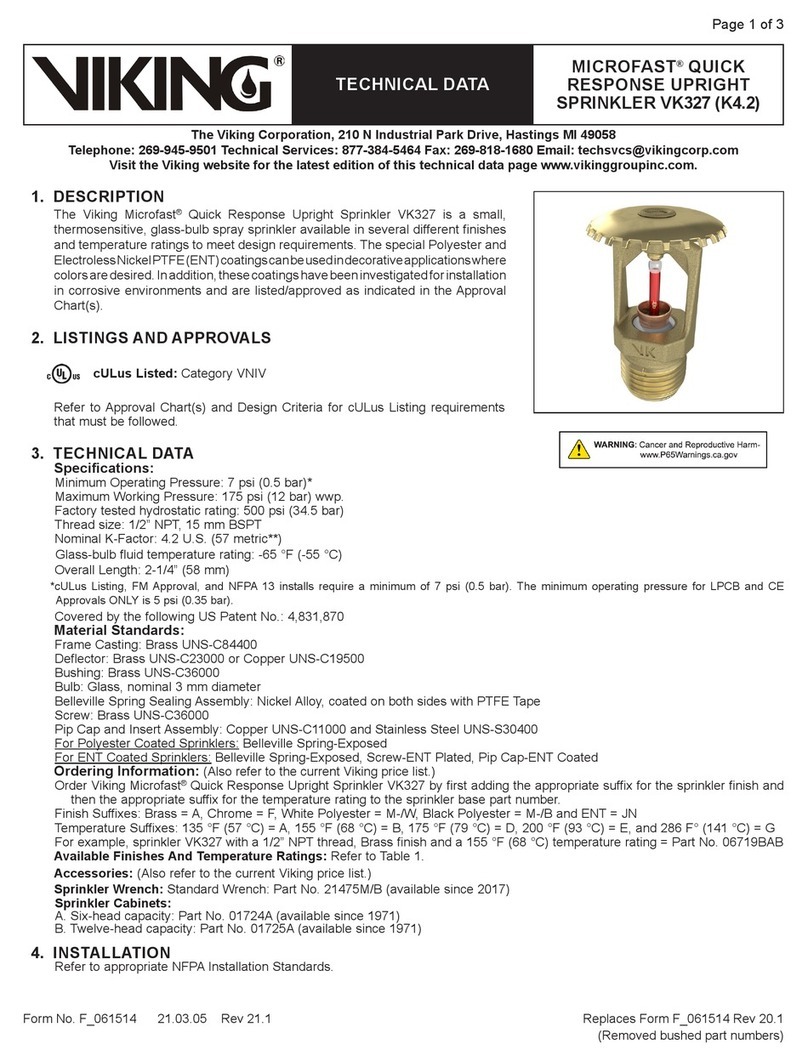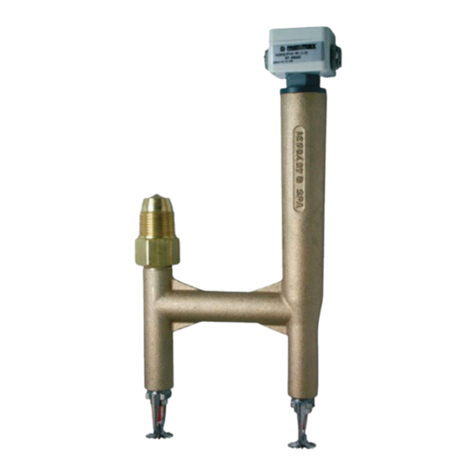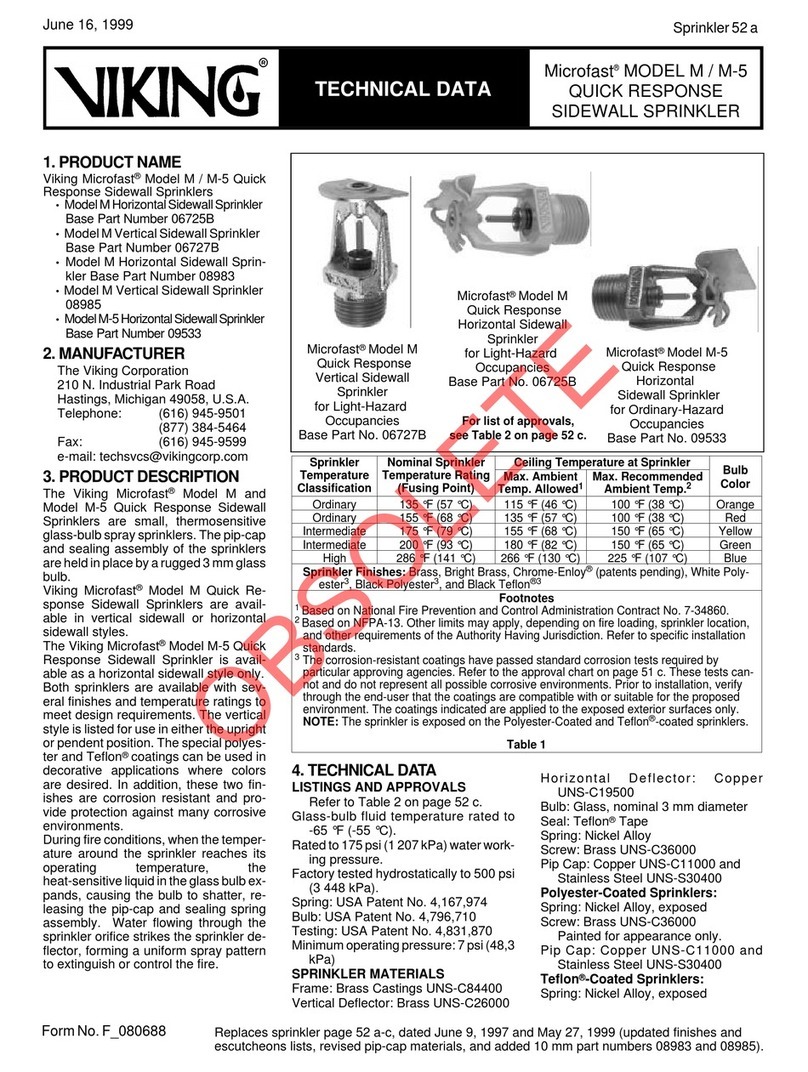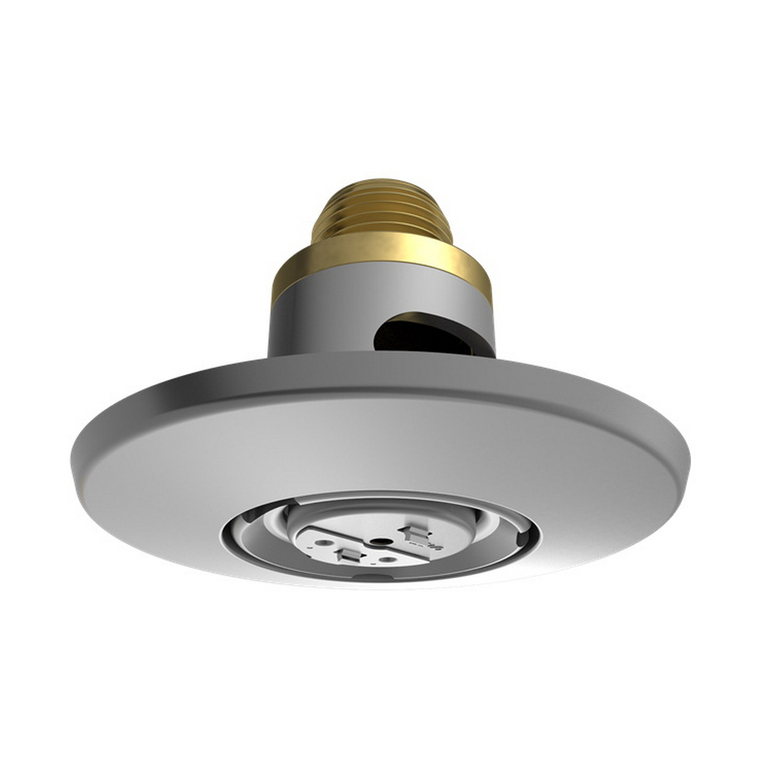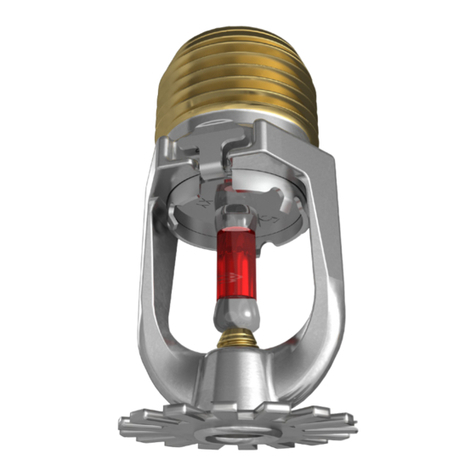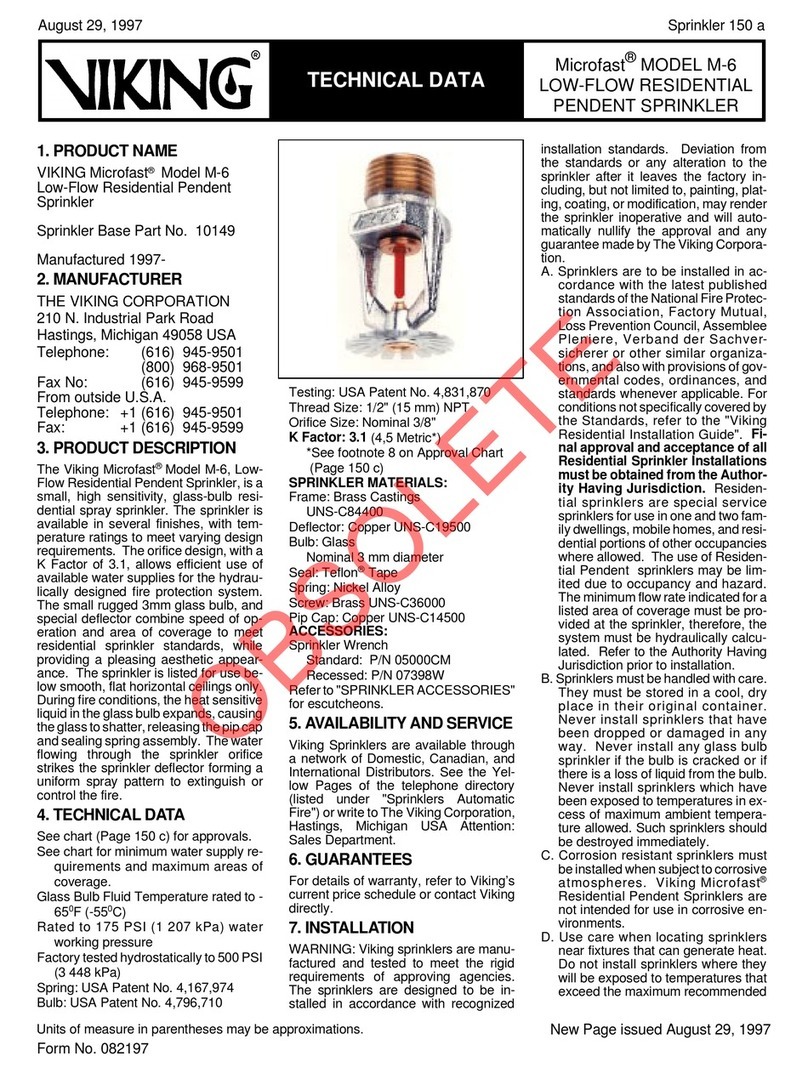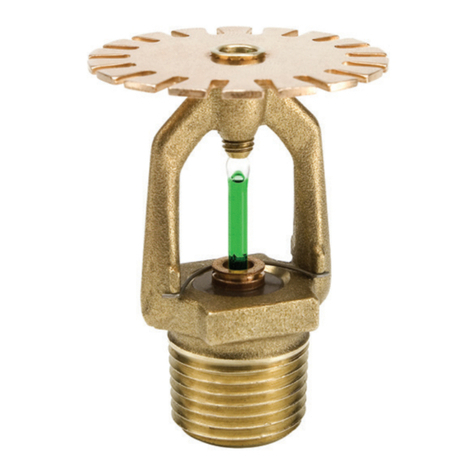
QUICK RESPONSE
SPRINKLERS
GENERAL CARE, INSTALLATION,
AND MAINTENANCE GUIDE
TECHNICAL DATA
May 19, 2006
Sprinkler QR2
Replaces page QR1-2, dated January 16, 2006 (updated for concealed sprinklers). Refer to the
appropriate sprinkler technical data page for detailed information on specific sprinkler models. Form No. F_011500
sprinkler model used. Refer to the appro-
priate sprinkler technical data page.
D. After installation, the entire sprinkler
system must be tested. The test must
be conducted to comply with the in-
stallation standards.
Viking high pressure sprinklers may
be hydrostatically tested at a maxi-
mum of 300 psi (2 069 kPa) for limit-
ed periods of time (two hours), for the
purpose of acceptance by the AHJ.
Make sure the sprinkler is properly
tightened. If a thread leak occurs, nor-
mally the sprinkler must be removed,
new pipe-joint compound or tape ap-
plied, and then reinstalled. This is due
to the fact that when the joint seal is
damaged, the sealing compound or
tape is washed out of the joint.
Air testing [do not exceed 40 psi (276
kPa)] the sprinkler piping prior to
testing with water may be considered
in areas where leakage during test-
ing must be prevented. Refer to the
Installation Standards and the AHJ.
E. Remove plastic protective sprin-
kler caps or bulb shields AFTER
the wall or ceiling finish work is
completed where the sprinkler is
installed and there no longer is a
potentialformechanicaldamageto
the sprinkler operating elements.
To remove the bulb shields, simply
pull the ends of the shields apart
where they are snapped together. To
remove caps from frame style sprin-
klers, turn the caps slightly and pull
them off the sprinklers. SPRINKLER
CAPS OR BULB SHIELDS MUST
BEREMOVEDFROM SPRINKLERS
BEFORE PLACING THE SYSTEM
IN SERVICE! Retain a protective cap
or shield in the spare sprinkler cabinet.
F1. For quick response flush style
sprinklers: the escutcheon ring can
now be installed onto the sprinkler
body. Align the escutcheon ring with
the sprinkler body and thread or
push it on (depends on sprinkler
model) until the outer flange touches
the surface of the ceiling or wall in
which the sprinkler is installed. Note
the maximum adjustment is 1/4” (6,35
mm) for quick response flush pendent
sprinklers and ½” (12,7 mm) for quick
response flush HSW sprinklers. DO
NOT MODIFYTHE UNIT. If necessary,
re-cut the sprinkler nipple as required.
F2. For QR concealed sprinklers:
the cover assembly can now be at-
tached.
Remove the cover from the protec-
tive box, taking care not to damage
When replacing existing sprinklers, the
system must be removed from service.
Refer to the appropriate system descrip-
tion and/or valve instructions. Prior to
removing the system from service, notify
all AHJs. Consideration should be given
to employment of a fire patrol in the af-
fected area.
A. Remove the system from service,
drain all water, and relieve all pres-
sure on the piping.
B. For frame-style sprinklers, use the spe-
cial sprinkler wrench to remove the old
sprinkler by turning it counterclock-
wise to unthread it from the piping.
For quick response flush and con-
cealed style sprinklers: Remove
the escutcheon ring or cover plate
assembly before unthreading the
sprinkler body from the piping.
Escutcheon rings and cover plates
can be removed either by gen-
tly unthreading them or pulling
them off the sprinkler body (de-
pends on the sprinkler model used).
After the escutcheon ring or cover
plate assembly has been removed
from the sprinkler body, place a plastic
shell (from the spare sprinkler cabinet)
over the sprinkler to be removed and
then fit the sprinkler wrench over the
shell.Thenuse thewrench tounthread
the sprinkler from the piping. Exception:
concealed sprinklers VK302, VK352,
VK462, VK463, and VK464 are re-
moved without the plastic cap.
C. Install the new unit by follow-
ing the instructions in section 6.
INSTALLATION. Care must be taken
to ensure that the replacement sprin-
kler is the proper model and style, with
the correct orifice size, temperature
rating, and response characteristics.
A fully stocked spare sprinkler cabinet
should be provided for this purpose.
For flush or concealed sprinklers:
stock of spare ceiling rings or cover
plates should also be available in the
spare sprinkler cabinet.
D. Place the system back in service and
secure all valves. Check for and re-
pair all leaks. Sprinkler systems that
have been subjected to a fire must
be returned to service as soon as
possible. The entire system must be
inspected for damage, and repaired
or replaced as necessary. Sprinklers
that have been exposed to corrosive
products of combustion or high ambi-
ent temperatures, but have not oper-
ated, should be replaced. Refer to
the Authority Having Jurisdiction for
minimum replacement requirements.
the cover plate assembly.
Gently place the base of the cover
plate assembly over the sprinkler pro-
truding through the opening in the
ceiling or wall.
Push the cover plate assembly onto
the sprinkler until the unfinished brass
flange of the cover plate base (or the
cover adapter, if used) touches the
surface of the ceiling or wall.
The maximum adjustment avail-
able for quick response concealed
sprinklers is ½” (12,7 mm). DO NOT
MODIFY THE UNIT. If necessary, re-
cut the sprinkler nipple.
G. If it is necessary to remove the entire
sprinkler unit, the system must be
taken out of service. See section 7.
MAINTENANCE and follow all warn-
ings and instructions.
7. MAINTENANCE
NOTICE: The owner is responsible for
maintaining the fire-protection system
and devices in proper operating condi-
tion. For minimum maintenance and
inspection requirements, refer to the ap-
propriate NFPA standard that describes
care and maintenance of sprinkler sys-
tems. In addition, the AHJ may have ad-
ditional maintenance, testing, and inspec-
tion requirements that must be followed.
Sprinklers must be inspected on a regu-
lar basis for corrosion, mechanical dam-
age, obstructions, paint, etc. The fre-
quency of inspections may vary due to
corrosive atmospheres, water supplies,
and activity around the device.
Sprinklers or cover plate assemblies
that have been painted or mechanically
damaged must be replaced immediately.
Sprinklers showing signs of corrosion
shall be tested and/or replaced immedi-
ately as required. Installation standards
require sprinklers to be tested and, if
necessary, replaced after a specified
term of service. Refer to the installa-
tion standards (e.g., NFPA 25) and the
AHJ for the specified period of time
after which testing and/or replacement
is required. Sprinklers or cover plate
assemblies that have operated cannot
be reassembled or re-used, but must
be replaced. When replacing sprinklers,
use only new sprinklers and cover plate
assemblies.
The sprinkler discharge pattern is criti-
cal for proper fire protection. Therefore,
nothing should be hung from, attached
to, or otherwise obstruct the discharge
pattern.All obstructions must be immedi-
ately removed or, if necessary, additional
sprinklers installed.
